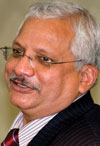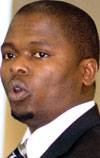
The BiometriX 2009 conference pulled in a record number of delegates and proved a fitting successor to the 2008 event. This year the focus was on integrated identity and access management.
The issue of identity is crucial in today’s society. Whether it is the confidence (or lack of it) that your personal identity information is safely stored and used responsibly by authorities for your and society’s benefit, the access an identity offers to social and safety services in a country where personal identification is considered paramount, or the ability for businesses to accept non-cash forms of payment with the assurance that the customer is who they claim and the payment will be honoured by banks.
As can easily be understood, identity is not a standalone application; it depends on the systems, policies and procedures surrounding the identity of a person to be of any value to the individual or company, government or police service. In today’s technology-rich world, the question of biometric forms of identity recognition and management is a crucial aspect of the identity solution.
As such, the BiometriX 2009 conference focused on the current state and future of integrated identity management (IIM) in South Africa and the world.
In his opening presentation, chairman of the day’s proceedings, Sanjay Dharwadker, regional manager of Sagem Security South Africa, noted that about three billion individuals have their biometrics on some sort of identification system worldwide. Of course, these are not all national identity systems, but the trend to trust the accuracy and speed of biometrics is irreversible.

Giving a brief background to fingerprint biometrics, Dharwadker noted that records of using fingerprints for identification have been found in ancient China, Babylon and Persia. In 1686, an Italian, Marcello Malpighi from Bologna first scientifically noted the ridges, spirals and loops on the fingertips. This 1,8 mm thick layer of skin is known today as the Malpighi Layer.
In 1858, the first handprint of Rajyadhar Konai was recorded for legal purposes by William Herschel, governor of Hooghly, (Bengal, India). Herschel also recorded his own fingerprints for a period of 57 years and noted their unchanging nature. And so the evolution of fingerprints continued until 1900 when the classification and use of fingerprints was so evolved it was adopted by the British government on the report and recommendation of Edward Richard Henry. The following year, Scotland Yard set up a Fingerprint Bureau based on the Henry classification. And the evolution continues, with vascular recognition coming of age in South Korea around the year 2000.
While fingerprint biometrics are the oldest and most advanced form of identification at the moment, other forms, such as iris, palm, facial, vein, signature, speech and DNA are in various stages of development and will become more prevalent in the coming years.
Standards are crucial
It is all very well to recognise the uniqueness of biometric measurements and identification, but unless there are globally accepted standards and processes in recognising them and the attached person, chaos will result. There have naturally been significant efforts over the years to standardise all aspects of biometrics. As a global leader in the use of fingerprint biometrics, South Africa plays an important role in this effort.
A presentation on standards by Ideco’s Nick van der Merwe, also the convenor of the SC71Q standards committee on biometrics which will eventually integrate with other standards work from the ISO, other standards bodies, and locally, the SABS. Of course, the SABS is part of the process of developing global standards and implementing them locally.

At the moment, Van Der Merwe says the international standards we have are primarily from the ISO and IEC bodies (while the ILO is also important in decision-making). The move to adopt standards was given added impetus by the terrorist attacks in New York on 11 September, 2001. Additionally, issues in Europe such as the UK national identity document plans and other EU visa standards all depend on the adoption of common biometric standards. And, Van Der Merwe notes, this includes common interfaces between software and systems used in identification, access control etc.
The SABS SC71Q that he heads consists of technical experts from academia, technology R&D institutions, vendors, government and other private sector concerns. Its main activities include the review of and contribution to biometrics standards documentation in order to make recommendations to SABS on the adoption of international standards as South African national standards.
Van Der Merwe concluded his presentation by noting that South Africa has already made significant contributions to the global standards process in various bodies, and it has been a leader in adopting various standards as soon they are published.
Real-life identification benefits
The event’s keynote was delivered by Dr Jayant Banthia, chief technical advisor for UNFPA (United Nations Population Fund) in Nigeria. Banthia spoke on Biometrics as an aid for good governance in the 21st century. An in depth review of Banthia’s presentation can be found at http://securitysa.com/news.aspx?pklNewsId=33802Biometrics for good governance.
Next up was divisional commissioner Piet du Toit, from SAPS Criminal Record & Forensic Science Services, who spoke on biometrics as a tool for justice in society. Du Toit believes technology has enormous power to support the criminal justice process.

The use of biometrics in SAPS has a long history, with the force using fingerprints for identification for over 100 years. Its launch of the automated fingerprint identification system (AFIS) in 2002 made a large difference in operations of SAPS and it is now one of the world’s busiest AFIS Systems with over 6 million 10-print records on file, performing over 8000 searches each day.
Of course, SAPS is always keeping up-to-date with other biometric technologies, such as facial recognition to identify criminals in CCTV footage, even incorporating shots from multiple angles and 3D composite images to help identification. Given the popularity of DNA testing following shows like CSI, SAPS is also current on DNA research. Of course, he notes that DNA differs from other biometric measurements in that it requires a tangible physical sample opposed to an impression, image or recording.
Also, DNA matching is not done in realtime, nor are all stages of comparison always automated. It does not employ templates or feature extraction, but rather represents the comparison of actual samples, making the use of DNA somewhat different and more difficult. However, these are issues that will be resolved soon and technologies currently in development will change the face of crime and the landscapes where it occurs globally. The benefits of DNA is that it is unique to every individual on the planet and is obtainable from a variety of sources. Importantly, it also does not change during the life of the owner and it is accepted worldwide.
Changes and improved technology, and improved crime fighting techniques are very necessary in today’s world as the crime environment goes through its own set of changes as a result of globalisation, increasingly borderless societies, terrorism and changing criminal tactics – most often through the increasing use of technology. Law enforcement authorities are therefore adapting to meet these new threats with new tactics and technology.
It is not all plain sailing, however. As technology changes, so do the issues that have to be dealt with, including new issues of privacy, public policy, standards and so forth. Locally, new legislation is in the pipeline that will allow for DNA samples to be taken from all arrestees and stored on a national database, and there may be allowances for voluntary DNA samples to be given by members of the public for storage on a database as well. This could be used for identification at a later stage.
Looking ahead, research is opening the door to even better DNA collection and identification technologies that might, for example, at some stage, be able to provide a physical description of a perpetrator from DNA found at a crime scene. Of course, advances in technology will impact facial and biometric recognition services as well as the readers and recognition software. Smaller, faster, more accurate and more reliable is the focus.
Of course, the rest of us are not as exposed to cutting edge biometrics and have to make do with the current batch of systems and solutions available. Fortunately this is quite sufficient, as the next speaker confirmed.
Biometric transactions
The Malawi Switch Centre (MALSWITCH) was established in 1999 by the Reserve Bank of Malawi to create a mechanism of providing an easy to use, secure and guaranteed electronic payment infrastructure in Malawi as part of the country’s National Payment System Modernisation Programme. Dr Matthews Mtumbuka, head of technical services at MALSWITCH took the podium next to present an overview of the system and its benefits to both buyers and sellers in Malawi. Specifically, Dr Mtumbuka focused on how biometrics plays a crucial role in securing transactions.

MALSWITCH relies first and foremost on a national fibre backbone that links the MALSWITCH head office in Blantyre with its regional offices around the country. Through this redundant backbone, all financial transactions are verified and processed, reducing fraud and improving service delivery. The software foundations of the system are an EFT switch and an associated e-banking solution that actually handle the secure transactions, which range from ATM transactions, to Internet banking, e-cheque clearing and more.
The manner in which users can purchase goods is via a smartcard, which can then be used as a debit, ATM, shopping or fuel card. The card contains each user’s personal details as well as their biometric data, which is linked to the individual’s profile on the national AFIS database. Not only does the use of biometrics ensure the cardholder is who they claim to be, but it prevents unauthorised users from using someone else’s card.
When a user enrols for a MALSWITCH account, their details are collected by whichever institution enrols them, along with their electronically scanned fingerprints. The four best fingerprints are used to create a biometric key, which is compared to the national AFIS database to ensure the person is who they claim to be. Once cleared, the individual is issued with an IBA (Instant Bank Account) against his/her profile, the card is issued and the individual can start using it. Each transaction made with the card is electronically verified and the fingerprint biometric ensures only authorised people spend on their own cards.
To find out more, a full description was published in the September issue of Hi-Tech Security Solutions and is available on the website.
Healthy biometrics
Steve Fitzpatrick, operations director for iNathi Technologies followed Mtumbuka with a description of how biometrics plays a role in healthcare.

We know that primary healthcare and government hospital access is poor in South Africa. In the rural areas it is worse and we have people in wheelbarrows being pushed to hospital because they are so desperate to get some form of medical attention, even if there are endless queues and poor service. However, using IT and biometrics, rural hospitals can improve and speed primary care and make sure the optimal and correct service and medication is delivered efficiently and timeously.
The Bushbuckridge area has over 7000 patients registered in various clinics. Before iNathi changed the processes in the area from chaotic paper-based clinical offices to efficient, digital offices that register everyone via their fingerprints, a patient could easily be forgotten or registered at multiple locations, multiple times. The worst problem was that patients could often receive the incorrect diagnosis and therefore the incorrect medication – a fatal mistake for those with AIDS, tuberculosis or cholera.
Using biometric registration of patients and a network linking the clinics, a single patient can go to any clinic and have medical experts access and work from the same file, allowing them to receive the right diagnosis and medication in record time. Moreover, morale has improved significantly among healthcare workers as they can now deliver better service and see the results.
The system in place also allows clinics to send automatically SMS messages to patients notifying them of appointments or the need to collect their monthly supply of medication. The system is also efficient as over 32 000 records were converted to electronic format in 10 months.
Fitzpatrick adds that the system works because it was developed with the healthcare workers, not simply imposed on them. It is continually expanding and making significant inroads into improved healthcare in rural areas.
Biometric borders and integrated identity
Michelle Kinnane, national manager, Strategic Development (Passengers) with the Australian Customs and Border Protection Services was up next with a presentation on how the Australian customs services have made use of facial recognition and electronic passports to speed the process of admitting people into Australia. See Facial recognition comes of age down under.
Gary Chalmers, CEO of local biometrics company iPulse followed. Chalmers discussed the benefit of using biometric identification as a way to automate processes across the enterprise, from physical through to logical access and further. Integrated identity management (IIM) is a complex process, but possible when planned correctly.

Chalmers went on to look at some issues critical to the IIM process, such as the difference between identification (establishing the identity of people) and verification (confirming that a claimed identity is real and valid). He added that confidentiality, integrity and availability affect all security decisions and biometrics therefore was not a solution, but an integral part of the solution.
He explained that an effective solution is built on seven principles:
1. Privacy
2. Identification
3. Authentication
4. Authorisation
5. Auditing
6. Accountability
7. Non-repudiation
Chalmers went further to describe four steps of IIM:
1. ID management
2. ID control
3. ID replication
4. ID foundation
He noted that IIM is an all inclusive process and policy-oriented security approach. When combined with a policy based on specific identity data, it means greater consistency and confidence in security processes across the enterprise.
Facial biometrics
The event also touched on the increasing use of facial biometrics, with Interoptic Network’s Basia Nasiorowska offering a look into the workings of facial recognition in business.

Nasiorowska touched on the technology behind facial biometrics as well as the standards employed globally to ensure a consistent approach to capturing and using facial biometric information. She followed this by highlighting a test done in a shopping centre where different people were enrolled either online and offline, and then accurately identified by a high-quality camera as they walked by as if on a normal shopping expedition.
The day was closed by a panel discussion, chaired by Goitsilwe Lesetedi, officer commanding, CBR, with the Botswana Police Service where questions from the floor were debated.

From the delegate response forms, BiometriX 2009 was what the doctor ordered in these tough economic times when security and identity issues are increasingly important to both the public and private sector. And what is more, the forms gave the organisers good recommendations as to the direction BiometriX 2010 should take.
© Technews Publishing (Pty) Ltd. | All Rights Reserved.